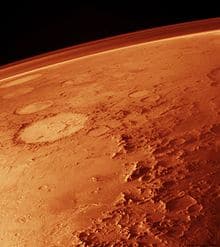The Radiation Assessment Detector, the first instrument on NASA’s next rover mission to Mars to begin science operations, was powered up and began collecting data Dec. 6, almost two weeks ahead of schedule. RAD is the only instrument scheduled to collect science data on the journey to Mars. The instrument is measuring the energetic particles inside the spacecraft to characterize the radiation environment an astronaut would experience on a future human mission to the Red Planet.
“The first data packets from RAD look great,” said RAD principal investigator Don Hassler, science program director in the Space Studies Department at Southwest Research Institute. “We are seeing a strong flux in space, even inside the spacecraft, about four times higher doses of radiation than the baseline we measured on the launch pad from the RTG, or radioisotope thermoelectric generator, used to power the rover. It’s very exciting to begin the science mission.”
The Mars Science Laboratory, launched Nov. 26, will land a sophisticated car-sized rover called Curiosity on the surface of the planet in August 2012. Loaded with 10 instruments including RAD, Curiosity will traverse the landing site looking for the building blocks of life and characterizing factors that may influence life, such as the harsh radiation environment expected on Mars.
“RAD was designed for the science mission to characterize radiation levels on the surface of Mars, but an important secondary objective is measuring the radiation on the almost nine-month journey through interplanetary space, to prepare for future human exploration,” said Hassler. “RAD is an important bridge between the science and exploration sides of NASA.”
RAD will measure the relevant energetic particle species originating from galactic cosmic rays, the Sun and other sources. Of particular interest are the particles accelerated by coronal mass ejections on the surface of the Sun, which spew fast-moving clouds of radiation across the solar system.
“Not only will this give us insight into the physics of these giant clouds, but as particles from these clouds hit the spacecraft, an inward cascade of secondary particles is released inside the capsule, which could pose a potentially greater biological hazard,” said Hassler. “Like an astronaut, RAD is tucked inside the spacecraft for the journey and will characterize these secondary particle showers. RAD also measures the higher energy galactic cosmic rays and the secondary particles that they produce inside the spacecraft.”
RAD will collect data nearly continuously during cruise and will downlink data every 24 hours. Positioned in the left center of the rover, the instrument is about the size of a coffee can and weighs about three pounds, but has capabilities of an Earth-bound instrument nearly 10 times its size. RAD detects charged particles arriving from space and will measure neutrons and gamma rays coming from Mars’ atmosphere above, or the surface material below, the rover.
SwRI, together with Christian Albrechts University in Kiel, Germany, built RAD with funding from the NASA Human Exploration and Operations Mission Directorate and Germany’s national aerospace research center, Deutsches Zentrum für Luft- und Raumfahrt.
The Mars Science Laboratory is a project of NASA’s Science Mission Directorate. The mission is managed by NASA’s Jet Propulsion Laboratory, a division of Caltech. The mission’s rover was designed, developed and assembled at JPL.
URL for image downloads is: http://swri.org/press/2011/rad.htm.
Information about the mission is available at: http://www.nasa.gov/msl and http://mars.jpl.nasa.gov/msl.
If our reporting has informed or inspired you, please consider making a donation. Every contribution, no matter the size, empowers us to continue delivering accurate, engaging, and trustworthy science and medical news. Independent journalism requires time, effort, and resources—your support ensures we can keep uncovering the stories that matter most to you.
Join us in making knowledge accessible and impactful. Thank you for standing with us!

